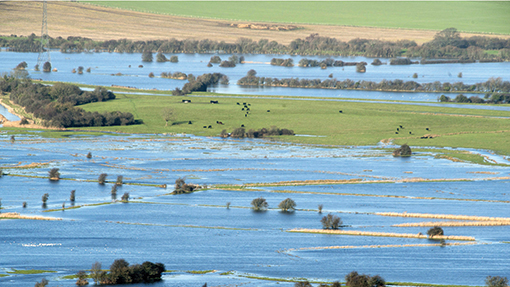Flooded fields mean anxious wait for growers

Flooded arable growers face an agonising time to see if their under water crops survive or they will be forced to redrill with spring crops once dry weather returns.
Cereal crops can survive waterlogged and flooded soils for up to a month in cold weather when growth is restricted, but in current mild conditions this could be shorter.
Flooding has hit arable land including the Thames Valley, close to the River Severn and in the South West although most in the East have escaped the worst rainfall.
See also: Flooded farmer tells Cameron ‘I’m facing crisis’
Crop experts say much of the flooding is on deeper-rooting permanent grassland rather than arable crops and so this meadow land is more likely to survive a limited time under water.
Scientists at Rothamsted Research say flooded crops can survive up to three or four weeks, but even then they would suffer from a lack oxygen and the soil structure would be damaged.
“At the moment, the advice is to be patient, check drainage ditches and of course hope for a more favourable change in the weather,” says Rothamsted’s Darren Hughes.
He adds the research station is already looking at developing future varieties, technologies and land management strategies to cope with more extreme weather.
Simon Oxley at the HGCA says when the water subsides then growers will have to assess plant populations and how much of their crops have survived, died, or simply been washed away.
“Crops can survive some waterlogging, and in cold temperatures can survive longer but there is little growers can do until the floods subside,” he says.
Dr Oxley points out that growers should be aware that soil-borne diseases, such as club root, which affects oilseed rape could be spread by the floodwater.
Much depends on how long crops are under water and at least most were looking better than last season before the floods, says Andrew Watts, chairman of the NFU’s combinable crops board.
“The national arable picture might not be too adverse but in the Thames Valley things look pretty bleak,” he says.
Mr Watts highlights the mixed picture for arable growers saying he was hoping to plough some of his chalk land near Royston in Hertfordshire this week, while his heavier land near Hertford would need a few weeks to dry out before he could get on the land.
Crop consultant Iain Richards at distributor Agrii reports some crops in the Thames Valley have been underwater for sevveral weeks and are unlikely to have survived, but all growers can do is to wait. His full report is on p58.
Other crop experts warn that rooting systems may look okay but are unlikely to be growing in waterlogged soils and crops with stunted roots could be vulnerable in a dry spring.
Mark Glew, senior barley breeder at Limagrain, warns that winter barley may be more at risk than winter wheat which tends to survive better in the wet than barley.
David Leaper, arable technical manager at farming cooperative Openfield, says he has not yet seen any upturn in spring seed orders to replace waterlogged autumn-sown ones.
He says spring seed order are a little slower than usual this year reflecting the expected 40% fall in the spring barley area after near-record autumn drilling this season.
Current mild and wet weather is encouraging cereal diseases such as yellow rust in the East and brown rust in the South after half the number of air frosts than usual recorded this winter.
“With not as many frosts we are likely to see an early epidemic of yellow and brown rust if conditions continue mild,” says Jonathan Blake, fungicide expert at crop scientist group ADAS.
He believes that the rusts are a bigger potential threat in early spring than septoria, which is present in most crops but its spread is closely related to rainfall in April and May.
He suggest growers monitor crops and especially rust-susceptible varieties and treat with a triazole fungicide at T0 in March or even before if it is possible to travel on the land.

